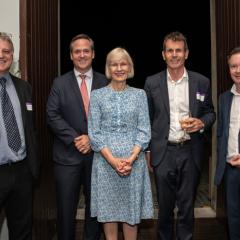The International Energy Agency (IEA) is tasked annually with constructing future energy demand scenarios at a global level and examining possible impacts on the world’s economies and greenhouse gas emissions – the IEA, World Energy Outlook.
On 24 February 2017, The University of Queensland, Centre for Coal Seam Gas and the UQ Energy Initiative, co-hosted the 5th IEA Unconventional Gas Forum at the Brisbane Conference and Exhibition Centre.
The forum was attended by over 75 delegates from 15 countries, including USA, Japan, United Kingdom, India, Norway, China, Indonesia, Argentina and Canada.
Its aim was to discuss and exchange experiences within unconventional gas development, in particular coalbed methane (CSG) across jurisdictions, with a view to informing future outlooks. Participants were invited by the IEA from member organisations.
Topics discussed varied from covering the IEA’s so-called “Golden Rules” for gas developments including socio-economic and environmental experiences.
Delegates also shared views of international implications due to the forecast rise of global demand for natural gas and the increasing share of trade that unconventional gas is forecast to take. The global LNG trade is also rapidly expanding and its dynamic changing, which has significant implications for Australia.
The Hon Matt Canavan, Minister for Resources and Northern Australia, and Dr Fatih Birol, Executive Director of the International Energy Agency, opened the day of dialogue, held as is the tradition under Chatham House Rule.
Warming up to the conference, over 20 participants went on a site visit the day before to the Australia Pacific LNG Condabri CSG field and water treatment facility to experience a large, modern coalbed methane field in action.
The Minister for State Development & Minister for Natural Resources & Mines, Queensland Government, Hon Dr Anthony Lynham later spoke of Queensland’s experiences, challenges and aspirations at the delegates’ dinner.
Here is a summary of the event by Prof Andrew Garnett, Director for the UQ Centre for Coal Seam Gas:
"Clearly on the strength of the global resource base, unconventional gas is here to stay and represents significant growth potential. Nevertheless, price challenges dominate and a “low price” outlook continues to dominate. A supply-price, oscillation in the medium to long term looks inevitable since new investments have ground to a halt. They’ll pick up again sometime after price rises and there’ll be an unsustainable spurt of investment (again) driven by individual reserves replacement pressures. In this rise CBM investments (except perhaps for brown field additions into existing contracts) will be last cab off the rank through lack of liquids.
During the session of social and environment, we heard, that social licence was not a matter to be won in the local communities (only) but, at least in the Australian setting, in the major cities. The way that licence is won in the local communities (deep, relationships with rich, evidence based communications) cannot work as distance grows and ‘word count’ and engagement time become limited. In, fact I think ‘political licence to operate’ (PLtO) might be a better moniker than SLtO. We also heard a salutary lesson on over-simplifying a story and of the persistence of negative first impressions. Our Canadian colleagues have recognised the key element that regulations play and explained the innovation of an International Centre of Regulatory Excellence (ICORE), which we here at UQ will follow up with great interest.
The two sessions on supply and markets (domestic and international) were revealing of very context-specific dynamics. We saw a need for direct incentives for unconventional gas in China, we saw gas prices collapse in the USA and Canada and Australian gas prices rise sharply (vs a long slow expected rise without CBM) as the previously isolated east coast gas market became linked to JCCC in the region. Perhaps the most startling difference was seen in the international trade changes. Cargoes have passed from the US though the Panama Canal. West coast USA or Canadian, LNG remains a possibility (though with highly uncertain timelines), the Atlantic Basin dynamic is changed, middle east LNG shifted east and Australia LNG going to 30+ countries rather than the traditional 4 or 5 main markets. In response to a long-forecast LNG over-supply, the demand side has responded by a rapid growth in re-gasification facilities (including floating re-gas). Molecules form Queensland have ended up in Abu-Dhabi, a country which produces and re-injects a significant amount of methane. The warning flags are out that our ability to forecast is severely tested.
Finally, the field visit to APLNG’s Condabri operations was an eye opener to many. The degree to which the “digital field” has taken hold is impressive. Electrification of field operations complete with real time monitoring of 1000’s wells, valves, manifolds, water plants, drilling rigs, compressors etc. opens new possibilities. The sheer amount of data being generated is already leading to optimisation and there is a general feeling that in these unconventional gas operations, new data analytics will help drive down the cost curve."



